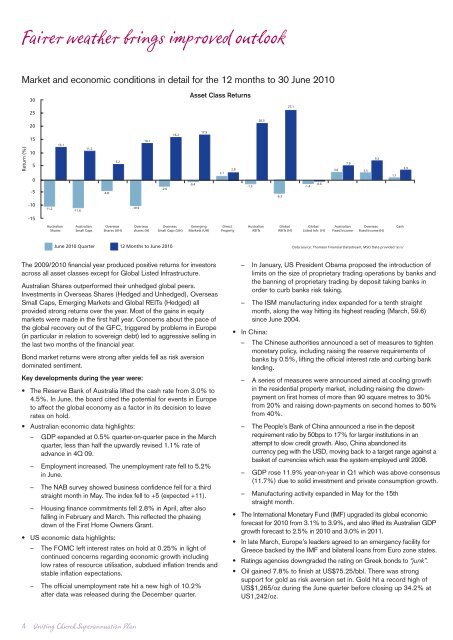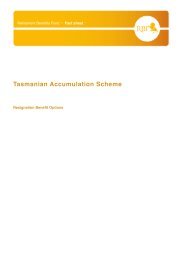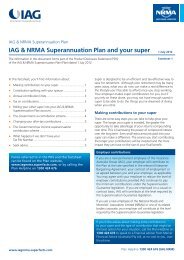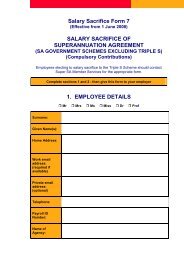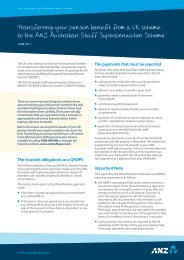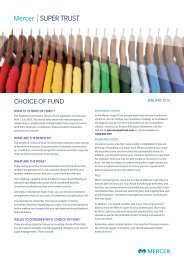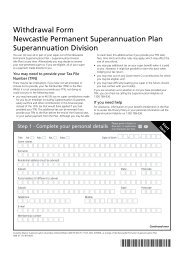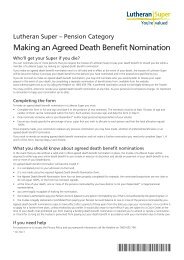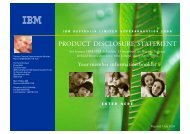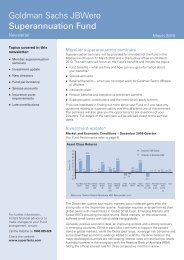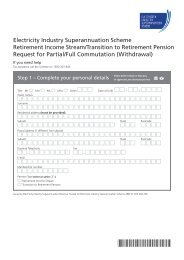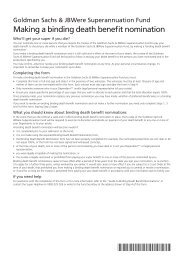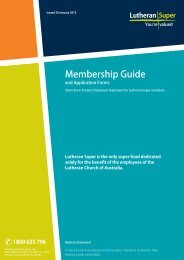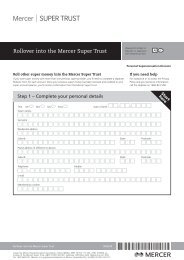Uniting Church Superannuation Plan - SuperFacts.com
Uniting Church Superannuation Plan - SuperFacts.com
Uniting Church Superannuation Plan - SuperFacts.com
Create successful ePaper yourself
Turn your PDF publications into a flip-book with our unique Google optimized e-Paper software.
Fairer weather brings improved outlook<br />
Market and economic conditions in detail for the 12 months to 30 June 2010<br />
30<br />
Asset Class Returns<br />
25<br />
27.1<br />
Return (%)<br />
20<br />
15<br />
10<br />
5<br />
0<br />
-5<br />
13.1<br />
11.2<br />
-4.8<br />
5.2<br />
14.1<br />
-2.6<br />
16.2<br />
-0.4<br />
17.9<br />
2.1<br />
2.8<br />
-1.5<br />
20.3<br />
-6.3<br />
-1.4<br />
-0.6<br />
3.6<br />
7.9<br />
3.5<br />
9.2<br />
1.1<br />
3.9<br />
-10<br />
-11.2<br />
-11.6<br />
-10.9<br />
-15<br />
Australian<br />
Shares<br />
Australian<br />
Small Caps<br />
Overseas<br />
Shares (UH)<br />
Overseas<br />
shares (H)<br />
Overseas<br />
Small Caps (UH)<br />
Emerging<br />
Markets (UH)<br />
Direct<br />
Property<br />
Australian<br />
REITs<br />
Global<br />
REITs (H)<br />
Global<br />
Listed Infr. (H)<br />
Australian<br />
Fixed In<strong>com</strong>e<br />
Overseas<br />
Fixed In<strong>com</strong>e (H)<br />
Cash<br />
June 2010 Quarter 12 Months to June 2010<br />
Data source: Thomson Financial Datastream; MSCI Date provided ‘as is’<br />
The 2009/2010 financial year produced positive returns for investors<br />
across all asset classes except for Global Listed Infrastructure.<br />
Australian Shares outperformed their unhedged global peers.<br />
Investments in Overseas Shares (Hedged and Unhedged), Overseas<br />
Small Caps, Emerging Markets and Global REITs (Hedged) all<br />
provided strong returns over the year. Most of the gains in equity<br />
markets were made in the first half year. Concerns about the pace of<br />
the global recovery out of the GFC, triggered by problems in Europe<br />
(in particular in relation to sovereign debt) led to aggressive selling in<br />
the last two months of the financial year.<br />
Bond market returns were strong after yields fell as risk aversion<br />
dominated sentiment.<br />
Key developments during the year were:<br />
• The Reserve Bank of Australia lifted the cash rate from 3.0% to<br />
4.5%. In June, the board cited the potential for events in Europe<br />
to affect the global economy as a factor in its decision to leave<br />
rates on hold.<br />
• Australian economic data highlights:<br />
– GDP expanded at 0.5% quarter-on-quarter pace in the March<br />
quarter, less than half the upwardly revised 1.1% rate of<br />
advance in 4Q 09.<br />
– Employment increased. The unemployment rate fell to 5.2%<br />
in June.<br />
– The NAB survey showed business confidence fell for a third<br />
straight month in May. The index fell to +5 (expected +11).<br />
– Housing finance <strong>com</strong>mitments fell 2.8% in April, after also<br />
falling in February and March. This reflected the phasing<br />
down of the First Home Owners Grant.<br />
• US economic data highlights:<br />
– The FOMC left interest rates on hold at 0.25% in light of<br />
continued concerns regarding economic growth including<br />
low rates of resource utilisation, subdued inflation trends and<br />
stable inflation expectations.<br />
– The official unemployment rate hit a new high of 10.2%<br />
after data was released during the December quarter.<br />
– In January, US President Obama proposed the introduction of<br />
limits on the size of proprietary trading operations by banks and<br />
the banning of proprietary trading by deposit taking banks in<br />
order to curb banks risk taking.<br />
– The ISM manufacturing index expanded for a tenth straight<br />
month, along the way hitting its highest reading (March, 59.6)<br />
since June 2004.<br />
• In China:<br />
– The Chinese authorities announced a set of measures to tighten<br />
monetary policy, including raising the reserve requirements of<br />
banks by 0.5%, lifting the official interest rate and curbing bank<br />
lending.<br />
– A series of measures were announced aimed at cooling growth<br />
in the residential property market, including raising the downpayment<br />
on first homes of more than 90 square metres to 30%<br />
from 20% and raising down-payments on second homes to 50%<br />
from 40%.<br />
– The People’s Bank of China announced a rise in the deposit<br />
requirement ratio by 50bps to 17% for larger institutions in an<br />
attempt to slow credit growth. Also, China abandoned its<br />
currency peg with the USD, moving back to a target range against a<br />
basket of currencies which was the system employed until 2008.<br />
– GDP rose 11.9% year-on-year in Q1 which was above consensus<br />
(11.7%) due to solid investment and private consumption growth.<br />
– Manufacturing activity expanded in May for the 15th<br />
straight month.<br />
• The International Monetary Fund (IMF) upgraded its global economic<br />
forecast for 2010 from 3.1% to 3.9%, and also lifted its Australian GDP<br />
growth forecast to 2.5% in 2010 and 3.0% in 2011.<br />
• In late March, Europe’s leaders agreed to an emergency facility for<br />
Greece backed by the IMF and bilateral loans from Euro zone states.<br />
• Ratings agencies downgraded the rating on Greek bonds to “junk”.<br />
• Oil gained 7.8% to finish at US$75.25/bbl. There was strong<br />
support for gold as risk aversion set in. Gold hit a record high of<br />
US$1,265/oz during the June quarter before closing up 34.2% at<br />
US1,242/oz.<br />
4 <strong>Uniting</strong> <strong>Church</strong> <strong>Superannuation</strong> <strong>Plan</strong>


